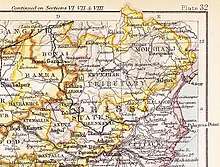Keonjhar State
Keonjhar State (Odia: କେନ୍ଦୁଝର), also known as Keunjhar, was one of the princely states of India during the period of the British Raj.[1] The second largest of the states of the Orissa States Agency, it was located in present-day Kendujhar district, Odisha.
| Keonjhar State କେନ୍ଦୁଝର | |||||||
|---|---|---|---|---|---|---|---|
| Princely State of British India | |||||||
| 12th century–1948 | |||||||
 Flag | |||||||
 Keonjhar State in the Imperial Gazetteer of India | |||||||
| Area | |||||||
• 1931 | 8,019 km2 (3,096 sq mi) | ||||||
| Population | |||||||
• 1931 | 460609 | ||||||
| History | |||||||
• Established | 12th century | ||||||
• Accession to the Union of India | 1948 | ||||||
| |||||||
The state was bounded in the north by Singhbhum District, in the east by the State of Mayurbhanj and Balasore District, in the south by Dhenkanal State and Cuttack District, and in the west by the states of Pal Lahara and Bonai. The state consisted of two clearly differentiated areas: Low Keonjhar, a region of flat river valleys — the main river being the Baitarani, and the High Keonjhar, an area of forests dominated by mountain ranges with the Gandhamadan reaching a height of 1078 m. The capital was at Keonjhar. [2]
History
Keonjhar State was founded sometime in the first half of the 12th century, the founder being Jati Singh (Jyoti Bhanj), brother of Adi Singh (Adi Bhanj), founder of Mayurbhanj State. Another version of the legend credits Jai Singh, a son of Man Singh, the Maharaja of Jaipur in Rajputana, who during a pilgrimage to the Jagannath shrine in Puri, married a woman named Padmavati, who was the daughter of Pratapendra Deb, the Gajapati King of Puri. Jai Singh received as a dowry the State of Hariharpur, which then comprised the two States of Mayurbhanj and Keonjhar. Padmavati bore him two sons: Adi Singh and Joti Singh. Following some successful territorial conquests, Adi Singh was given the title of Bhanj by the Gajapati King of Puri.[3]
Rulers
The rulers of Keonjhar State bore the title of Raja. The Keonjhar royal family adopted the emblems of the neighbouring State of Mayurbhanj, a peacock and the yellow and blue colours.[4]
Rajas
- 1688 - 1700 Jagannath Bhanj
- 1700 - 1719 Raghunath Bhanj
- 1719 - 1736 Gopinath Bhanj
- 1736 - 1757 Narsingh Narayan Bhanj
- 1757 - 1758 Daneswar Narayan Bhanj
- 1758 - 1762 Jagateswar Narayan Bhanj
- 1762 - 1794 Pratap Balbhadra Bhanj
- 1794 - 1825 Janardan Bhanj
- 1825 - 22 Mar 1861 Gadadhar Narayan Bhanj Deo (d. 1861) (personal style Maharaja from 1858)
- 4 Sep 1861 – 27 Oct 1905 Dhanurjai Narayan Bhanj Deo (b. 1849 - d. 1905?) (personal style Maharaja from 1 Jan 1877)
- 27 Oct 1905 – 12 Aug 1926 Gopinath Narayan Bhanj Deo (b. 1883 - d. 1926) (removed from authority from 1906)
- 1906 - 12 Aug 1926 McMillan -State Superintendent
- 12 Aug 1926 – 15 Aug 1947 Balbhadra Narayan Bhanj Deo (b. 1905 - d. c.1970)
References
- Chisholm, Hugh, ed. (1911). . Encyclopædia Britannica. 15 (11th ed.). Cambridge University Press. p. 749.
- Imperial Gazetteer of India, v. 15, p. 202
- Princely states - Keonjhar
- Princely States of India